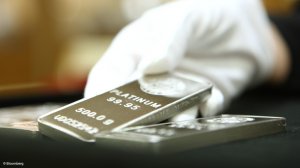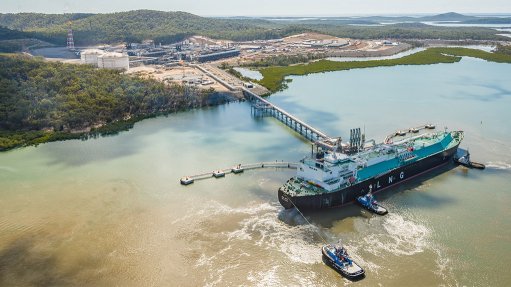Global economic recovery drives first-quarter platinum demand higher

WPIC research director Trevor Raymond gives Mining Weekly some more insight into the WPIC's latest 'Platinum Quarterly' report. Video: Creamer Media's Kutlwano Matlala. Editing: Creamer Media's Nicholas Boyd.
As the global economy continued to recover, boosted by widespread stimulus measures, demand for platinum increased by 26% or about 405 000 oz year-on-year to more than 1.9-million ounces in the first quarter, the World Platinum Investment Council (WPIC) notes in its latest ‘Platinum Quarterly’ report.
For the fourth consecutive quarter, platinum posted a small deficit of 19 000 oz in the first quarter, as strong industrial, automotive and jewellery demand and sustained investment demand for platinum outstripped recovering but constrained supply.
WPIC research director Trevor Raymond notes that the “once in a lifetime fiscal stimulus programmes put in place by multiple governments to try and get economies out of the hole caused by the Covid pandemic” resulted in significant spending, which reached all areas and prompted the growth in demand seen in the first quarter of the year.
Demand for platinum in the glass sector also contributed, with anticipated growth of 70% year-on-year likely this year as the demand for flat screens increase, while decarbonisation efforts and the goal to insulate buildings better continue.
“A lot of glass fibre is going into building insulation and there have been significant increases in the capacity for glass and glass fibre production, particularly in China.”
A change in personal income and an increased motivation to drive own vehicles, owing to the risk of infection on public transport, as well as a long delay in fleet adjustments during 2020, also impacted on demand.
There has been a 16% increase in the first quarter in vehicle production, despite a shortage of microchips, while the increased certainty of the hydrogen economy and decarbonisation, have also influenced expected growth in platinum demand.
Meanwhile, following the effects of operational shutdowns and Covid-19-related restrictions in 2020, greater output from South Africa, an increase in production from Russia and growth in recycling, resulted in platinum supply increasing by 11% or about 187 000 oz to more than 1.9-million ounces in the first quarter.
While total supply is forecast to rise by 16% to 7.8-million ounces in 2021, this is still some way off levels seen pre-pandemic (8.2-million ounces in 2019).
The demand for platinum is also expected to increase by 5% (378 000 oz) to just over 8-million ounces, with 2021 set to generate a deficit for the third year running of 158 000 oz.
INDUSTRIAL DEMAND
Industrial demand in the first quarter was 44% (201 000 oz) higher than in the first quarter of 2020, and was underpinned by a six-fold increase in demand year-on-year from the glass sector to 279 000 oz.
Glass demand is forecast to increase by 70% in the next year, as demand growth for use in screens and building materials is met by capacity expansions, mainly in China.
The improvement in economic activity will see demand for platinum in industrial applications increase by 25% (486 000 oz), the WPIC says, with notable increases in demand from the chemical (11% or 62 000 oz) and petroleum (65% or 71 000 oz) sectors.
The ‘other’ industrial segment surged by 23% (27 000 oz) in the first quarter and is expected to grow by 17% (85 000 oz) in 2021 and includes growth in automotive (for use in spark plugs and sensors) and the green hydrogen industries (increased stationary fuel cell deployment and early production of green hydrogen from renewable electricity).
Automotive demand is forecast to exceed 2019 levels, despite supply chain curtailment, which the WPIC said is “testament to the strength of the recovery”, as higher vehicle production and tighter emissions regulations contributed to an 8% (50 000 oz) in automotive demand for platinum in the first quarter, despite production being undermined by semiconductor shortages and a tightening of lockdown measures in some regions.
North America, in particular, saw platinum demand increase by 12% (10 000 oz), helping to offset declines in other parts of the world.
In China, burgeoning vehicle ownership aspirations and the continued implementation of more stringent emissions legislation took first-quarter platinum demand to 85 000 oz – almost double that of the year before.
For 2021, despite supply chain challenges, the WPIC believes global light-duty vehicle production is expected to be 16% higher than in 2020, while heavy-duty output forecast to improve by 3%.
This will result in an increase in automotive platinum demand of 22% (557 000 oz) to more than 2.9-million ounces, thereby exceeding pre-pandemic levels.
Jewellery demand, meanwhile, recovered by 22% (85 000 oz) year-on-year in the first quarter, with notable fabrication demand increases in China (55%, 70 000 oz), India (35%, 6 000 oz), and North America (14%, 11 000 oz).
In 2021, platinum jewellery is expected to recover, growing 9% (158 000 oz) above the prior
year to almost two-million ounces, and close to 2019 levels at almost 2.1-million ounces, with improvements expected particularly in the North American, European and Indian markets.
INVESTMENT DEMAND
During the first quarter, overall investment demand increased by 96% (69 000 oz) year-on-year to 140 000 oz.
Exchange-traded fund (ETF) holdings grew for the fourth consecutive quarter in the first quarter, as anticipated substitution gains in autocatalysts and platinum’s use in hydrogen technologies continued to attract investor interest.
This helped to offset a 288 000 oz fall in bar and coin demand, which the WPIC says was “almost entirely owing to some Japanese investors capitalising on platinum price strength and
selling back to the market”.
This was a typical reaction in Japan as platinum went above the historically key 4 000 Yen per gram level in what is considered to be the most mature market for platinum bars and coins.
While platinum investment is expected to remain strong in 2021 at 726 000 oz, it may not exceed the exceptional level seen in 2020, the WPIC notes.
Commenting on the investment demand for platinum versus other metals, such as gold or palladium, Raymond says that while gold continues to react to risk, platinum saw increased interest and continues to trade at a premium, compared with the yellow metal.
In terms of the other metals, the industry has seen tin, aluminium, nickel and copper having “enormous surges” as the economic recovery occurs post-Covid-19.
Palladium is considered key, particularly as palladium and platinum both play a key role in being substitutes for gasoline catalysts at a 1:1 ratio. “That substitution has started to come, and the details are coming out slowly. There is a good agreement that it will be an additional half-million ounces of platinum demand [a year] in four years. That growth is enormous and [implies] that the disconnect in the prices is causing that substitution,” he commented.
This also means, however, that there is no reason that platinum should not be the same price as palladium because the main reason for the platinum price being as high as it is China’s implementation of China 6 regulations, with the country’s passenger vehicles being almost exclusively gasoline.
“It is really the Chinese automaker buying that is keeping the palladium price hugely escalated. So, from a price perspective, there is no reason why platinum shouldn’t move towards and past gold’s price, and more towards palladium’s price, as these prices adjust as we’ve seen them do over the last 20 years,” Raymond tells Mining Weekly.
ETF holdings, meanwhile, are expected to rise by 250 000 oz in 2021 as enthusiasm for platinum’s demand fundamentals will continue to prompt fresh investment inflows.
Meanwhile, forecast bar and coin demand remains strong at 436 000 oz, albeit down from last year’s historically high 586 000 oz.
In a separate statement on May 17, WPIC CEO Paul Wilson commented that previous iterations of the Platinum Quarterly “saw the wheels of the global economy beginning to turn steadily as vaccination rates escalated and once-in-a-generation fiscal stimulus packages were implemented”.
Compared with the first quarter of 2021, industry is now see growing momentum and economies shifting through the gears, he said, though he warned that there continues to be setbacks and that the industry “may see further tragic twists and turns in how the global pandemic is resolved, adding caution to any optimism”.
“Today’s report points to the fact that platinum demand and supply sectors are poised to benefit from this rapid recovery and support. In addition to stimulus packages, climate action is now heavily featured on many governments’ agendas, adding further impetus to the attraction of green technology metals such as platinum.
“Manufacturing sectors gaining momentum will increase platinum consumption, and in turn this will stimulate investment activity – for both short- and long-term investors,” he said, echoeing sentiments shared by Raymond.
Wilson added that the recent interest in commodities, as well as platinum’s linkage to the hydrogen economy, is driving a number of investors to consider platinum.
“When these investors take a closer look, they see that platinum’s constrained supply, deep discount to gold and palladium and compelling demand growth potential greatly enhance the likelihood of investment demand growth,” he said.
Comments
Press Office
Announcements
What's On
Subscribe to improve your user experience...
Option 1 (equivalent of R125 a month):
Receive a weekly copy of Creamer Media's Engineering News & Mining Weekly magazine
(print copy for those in South Africa and e-magazine for those outside of South Africa)
Receive daily email newsletters
Access to full search results
Access archive of magazine back copies
Access to Projects in Progress
Access to ONE Research Report of your choice in PDF format
Option 2 (equivalent of R375 a month):
All benefits from Option 1
PLUS
Access to Creamer Media's Research Channel Africa for ALL Research Reports, in PDF format, on various industrial and mining sectors
including Electricity; Water; Energy Transition; Hydrogen; Roads, Rail and Ports; Coal; Gold; Platinum; Battery Metals; etc.
Already a subscriber?
Forgotten your password?
Receive weekly copy of Creamer Media's Engineering News & Mining Weekly magazine (print copy for those in South Africa and e-magazine for those outside of South Africa)
➕
Recieve daily email newsletters
➕
Access to full search results
➕
Access archive of magazine back copies
➕
Access to Projects in Progress
➕
Access to ONE Research Report of your choice in PDF format
RESEARCH CHANNEL AFRICA
R4500 (equivalent of R375 a month)
SUBSCRIBEAll benefits from Option 1
➕
Access to Creamer Media's Research Channel Africa for ALL Research Reports on various industrial and mining sectors, in PDF format, including on:
Electricity
➕
Water
➕
Energy Transition
➕
Hydrogen
➕
Roads, Rail and Ports
➕
Coal
➕
Gold
➕
Platinum
➕
Battery Metals
➕
etc.
Receive all benefits from Option 1 or Option 2 delivered to numerous people at your company
➕
Multiple User names and Passwords for simultaneous log-ins
➕
Intranet integration access to all in your organisation



















